Morocco << muh ROK oh >> is a country in the northwestern corner of Africa. It is bordered by the Mediterranean Sea on the north and the Atlantic Ocean on the west. The Strait of Gibraltar, which connects the Mediterranean and the Atlantic, separates Morocco from Spain by only about 8 miles (13 kilometers). Fertile plains lie along Morocco’s coasts, and forested mountains stretch across the middle of the country from southwest to northeast. Beyond the mountains lies a sun-baked desert, the Sahara. Rabat is Morocco’s capital, and Casablanca is the largest city.
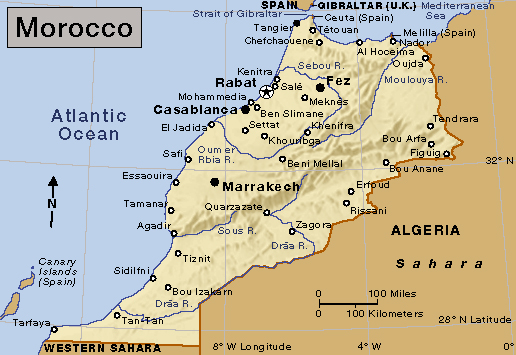
Nearly all Moroccans are of mixed Arab and Berber descent. But the people make up two distinct ethnic groups—Arab and Berber—depending mainly on whether they speak Arabic or Berber. Almost all Moroccans are Muslims. Farming is the chief occupation. France and Spain controlled Morocco from the early 1900’s until it won independence in 1956.
Government
National government.
Morocco is a constitutional monarchy headed by a king. The king commands the armed forces, ratifies international treaties, and has broad powers involving national security and religious affairs.
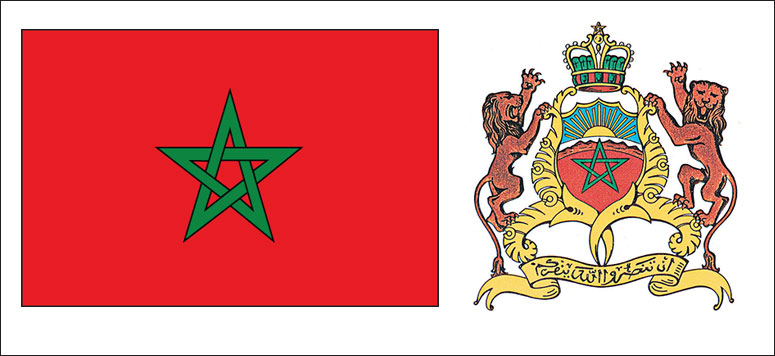
The day-to-day work of Morocco’s government is carried out by a prime minister, appointed by the king, and a Cabinet of other ministers. Morocco has a two-house legislature. Members of the Chamber of Representatives are elected by the people to five-year terms. Members of the Chamber of Councillors are chosen by representatives of local governments, professional organizations, and other groups. Members serve six-year terms. All citizens who are 18 years of age or older may vote.
Local government.
Morocco is divided into regions. The regions are further divided into wilayas, prefectures, and provinces, and these three administrative units are divided into urban councils, rural councils, and communes. The king appoints the regional governors. The urban, rural, and communal councils elect regional councils.
Politics.
The Union Constitutionnelle (Constitutional Union), the Mouvement Populaire, and the Rassemblement National des Independants (National Rally of Independents) are Morocco’s largest political parties that have generally supported the king’s policies. The most prominent of the opposition parties are the Union Socialiste des Forces Populaires (Socialist Union of Popular Forces), which backs broad socialist reforms, and the Istiqlal, which takes a more conservative approach to domestic issues. Other parties include the Mouvement National Populaire (National Popular Movement), the Parti du Progrès et du Socialisme (Party of Progress and Socialism), and the moderate Islamist Justice and Development Party.
Courts.
Morocco’s highest court is the Supreme Court. Lower courts include appeals courts, regional courts, and sadad (conciliation or peace) courts.
Armed forces.
Morocco has an army, navy, and air force. Military service is voluntary.
People
Ancestry.
Almost all Moroccans are of mixed Arab and Berber ancestry. Berbers lived in what is now Morocco as long as 3,000 years ago. Arabs began to move into the area during the 600’s. Over the years, the two groups intermarried so extensively that today there are few Moroccans of unmixed Arab or Berber ancestry. People are identified as Arabs or Berbers chiefly by their main language, Arabic or Berber. According to Morocco’s government, Arabs form nearly 65 percent of the population, and Berbers make up the rest.
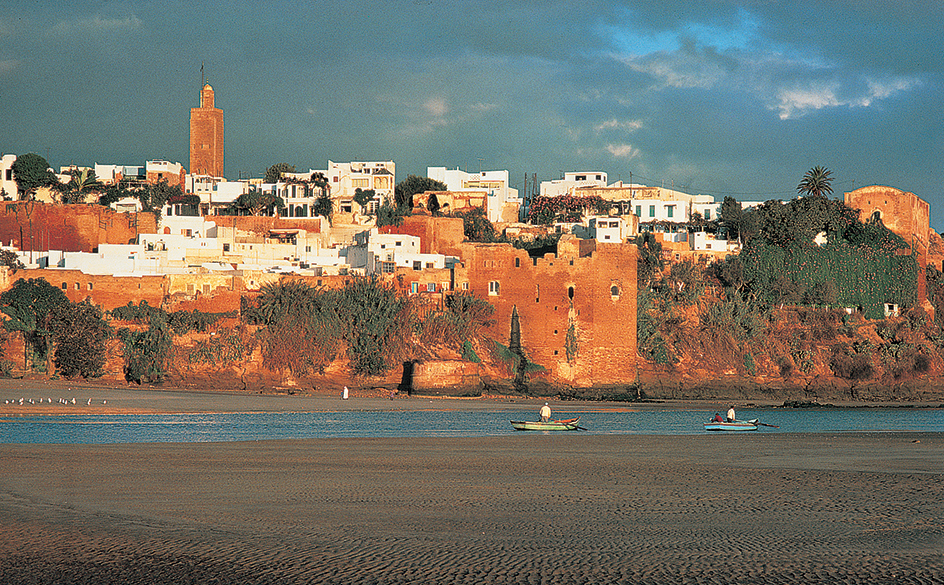
Languages.
Arabic is the official language of Morocco. It is spoken not only by Arabs but also by many Berbers in addition to their own language. A large number of Arabs and Berbers also speak French or Spanish.
Religion.
Islam is Morocco’s official religion. About 98 percent of the people are Muslims, and Islamic teachings regulate family and community life. Morocco also has some Christians and Jews.
Way of life.
The traditional Moroccan household consists of two parents, their unmarried children, their married sons, and those sons’ wives and children. When the father dies, each married son begins his own household. In crowded urban areas, many households split up before the father’s death because there is not enough room for everyone to live together.
Housing in rural Morocco varies according to climate and available building materials. Many people in the southern part of the country live in houses of dried mud bricks. In other rural areas of Morocco, houses are made of wood and stone.
Many rural houses have only one large room. This room serves as kitchen, living room, sleeping quarters, and barn. People gather at a weekly outdoor market called a suq to buy and sell goods and chat with neighbors. In desert regions, a small number of people lead a nomadic life and live in tents. 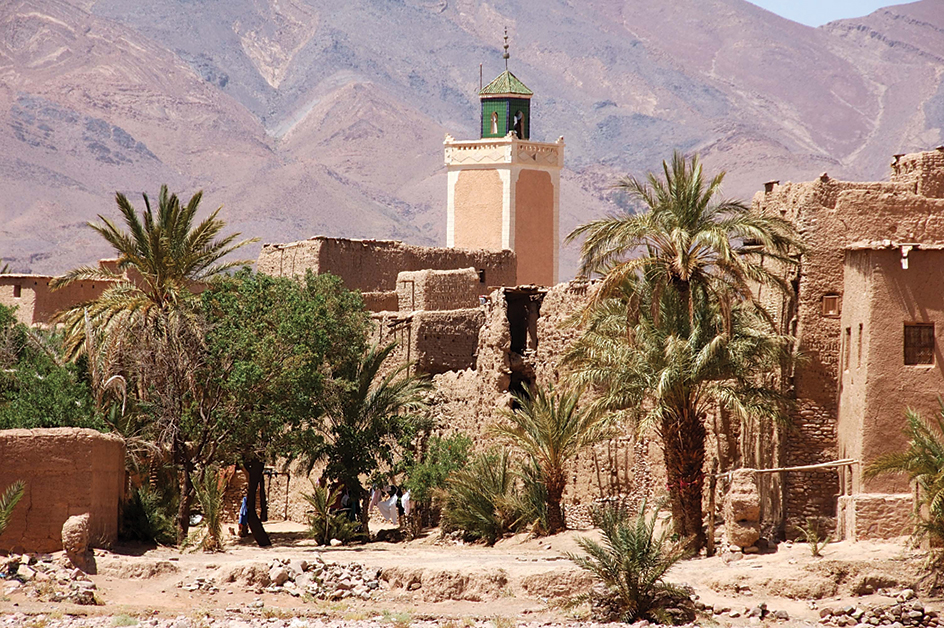
Many urban Moroccans live in small attached houses. Wealthier people live in spacious houses or modern apartment buildings. Sprawling slums called bidonvilles (tin can towns) border the large cities. The name bidonville comes from the flattened tin cans, or bidons, used to build many of the slum shacks. Severe overcrowding exists in the medinas of Morocco’s large cities. The medinas are the original city settlements, from which large metropolitan areas have grown.
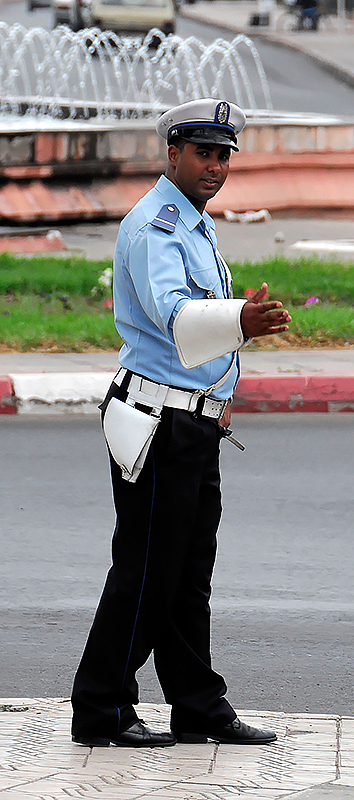
People throughout Morocco wear traditional clothing, though city people often combine such clothing with Western garments. Outdoors, men wear a jellaba, a loose-fitting hooded robe with long, full sleeves. A burnoose is a similar but heavier garment worn chiefly by rural men. Most men wear a turban or a brimless cap. One type of cap, called a fez, is named for the Moroccan city of Fez. This red, flat-topped cap is now usually worn only for formal occasions.
Like men, women wear a jellaba as an outer garment. At home and at social affairs, they wear a long, beautiful robe called a caftan. Some older women and some rural women follow Islamic tradition and cover their face with a veil.
Food and drink.
Foods made of barley and wheat form the basis of most Moroccans’ diet. The national dish is couscous. It consists of steamed wheat served with vegetables, fish or meat, and a souplike sauce. Moroccans like pastries made with honey and almonds. The national drink is mint tea.
Recreation.
Spectator sports in Morocco include soccer, basketball, motorsport, and track and field. Soccer is played throughout the country, and boxing, fishing, golf, hiking, surfing, and tennis are also popular. Family visits and gatherings at cafes are common forms of relaxation. The people also enjoy many local and religious festivals throughout the year.
Education.
Morocco provides free elementary and high school education. Classes are taught in Arabic and French. Children are required to attend six years of school, but not all do so. Attendance is especially low in rural areas, which have a lack of teachers and schools. In addition, many rural boys stay at home to help their families farm the land. Moreover, many parents place less value on education for girls than for boys.
Morocco has five state secular (nonreligious) universities, the largest of which is Mohammed V University in Rabat. A private university, al-Akhawayn, is in Ifrane, near Azrou, and the Islamic university of al-Qarawīyīn is in Fez. Morocco also has a number of technical schools and institutes of higher education.
The arts.
Moroccans have long been known for their fine leather goods, rugs, pottery, and metalware. Many Moroccan arts reflect Spanish and French influences as well as Arabic and Berber traditions. For example, traditional Moroccan folk music and folk dances are often combined with the styles of the Andalusian region of southern Spain. French influences can be seen in painting, sculpture, and drama. Modern Moroccan authors, whether writing in Arabic or French, have often dealt with problems of cultural identity and have protested continuing French influences in Morocco.
Loading the player...Moroccan folk music
The land and climate
Land regions.
Morocco has three major land regions. They are (1) the Coastal Lowlands, (2) the Atlas Mountain Chain, and (3) the Sahara.
The Coastal Lowlands
border the Mediterranean Sea and the Atlantic Ocean. The land gradually rises from the Atlantic coast and forms a plateau that extends to the mountains. Rich farmland in the Coastal Lowlands is irrigated by water from the region’s many shallow rivers. Most of Morocco’s crops are grown there.
The Atlas Mountain Chain
crosses the middle of Morocco from southwest to northeast. The chain has three distinct ranges: (1) the Anti Atlas in the southwest; (2) the High Atlas, also called Haut Atlas, in the central area; and (3) the Middle Atlas, or Moyen Atlas, in the northeast. The Rif, a group of mountains in the far north, are sometimes included in the Atlas chain.
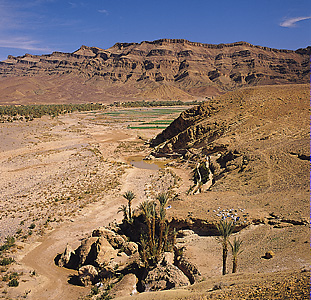
The Sahara
lies east and south of the Atlas Mountains. It is a barren region of sand dunes, rocks, stones, and scattered oases.
Climate.
Most of Morocco has two seasons, rainy and dry. The rainy season generally lasts from October or November to April or May. Nearly all the rainfall occurs in this period. Annual rainfall averages 9 inches (229 millimeters) in Marrakech and 21 inches (533 millimeters) in Rabat. Droughts sometimes occur in the dry season, from May or June to September or October. January temperatures average 66 °F (19 °C) in Marrakech and 63 °F (19 °C) in Rabat. June temperatures average 91 °F (33 °C) in Marrakech and 77 °F (25 °C) in Rabat.
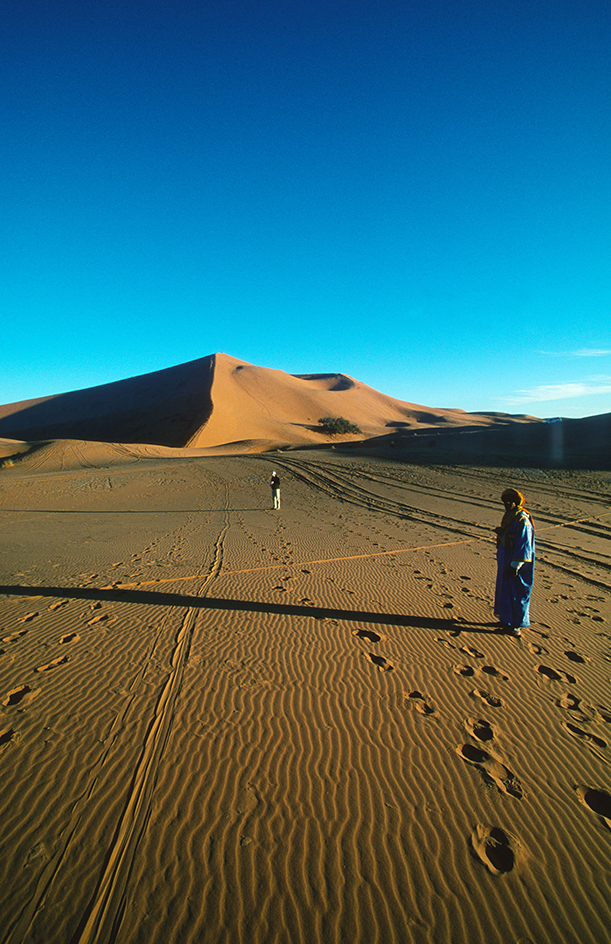
Economy
Morocco has a developing economy based largely on agriculture and mining. The government controls the mining industry, most transportation and communication services, and some manufacturing industries. However, most farms and businesses are privately owned. Foreign aid and remittances (money sent home) from Moroccans working abroad are helpful sources of national income.
Agriculture and fishing
employ about 40 percent of all workers in Morocco. At various times, droughts have caused sharp reductions in agricultural production. Morocco is one of the world’s leading olive-producing countries. Other crops include almonds, apples, barley, citrus fruits, grapes, onions, potatoes, tomatoes, and wheat. The chief livestock are beef and dairy cattle, chickens, goats, and sheep. Morocco is one of Africa’s leading fishing countries. Anchovies, mackerel, and sardines are caught off the coasts. Much of the catch is canned for export or processed into either fertilizers or animal feed.
Service industries
also employ about 40 percent of Morocco’s workers. These industries account for about half of the country’s total economic output. Tourism is a major service industry. Millions of tourists visit Morocco each year. Many tourists come from France, Spain, the United Kingdom, and other European countries. Many service industry workers are employed by hotels, restaurants, and resorts. The government and institutions that provide community services hire many other service workers.

Manufacturing
provides jobs for about 10 percent of Moroccan workers. Leading manufactures include automobiles, cement, chemicals, leather goods, processed foods, and textiles. Casablanca is the main industrial center.
Mining
employs less than 1 percent of Morocco’s labor force but is highly important to the economy. Morocco is the world’s largest exporter of phosphate rock, which is used to produce fertilizers and other chemicals. Morocco has over half of the world’s known reserves of phosphate rock. Other mineral products include barite, cobalt, copper, iron ore, lead, natural gas, petroleum, silver, and zinc.
Energy sources.
Most of Morocco’s energy needs are supplied by imports, mainly oil. The country has begun to increase the energy it produces from solar power, wind power, and other renewable resources.
Trade.
Morocco imports more than it exports. The chief imports include cotton, machinery, motor vehicles, petroleum and petroleum products, plastics, and wheat. Phosphate rock and phosphate products account for much of Morocco’s export income. Other exports include cars, clothing, electric wire, fish products, and food products. The nation’s key trading partners include China, France, Italy, Spain, the United Kingdom, and the United States.
Transportation and communication.
Highways and government-owned railroads link all major Moroccan cities with one another and with key agricultural and mining areas. A high-speed rail line connects Tangier, Rabat, and Casablanca. Agadir, Casablanca, and Marrakech have international airports. The government-controlled Royal Air Maroc provides international airline service. Casablanca and Tangier have major seaports.
A number of privately owned daily newspapers, printed in both Arabic and French, are published in Casablanca, Rabat, and Tangier. The government runs the major radio and television stations. Several privately owned radio and TV stations also broadcast programs. TV and radio programs are broadcast in Arabic, Berber, English, French, and Spanish.
History
Farming communities existed in what is now Morocco at least 8,000 years ago. By 1000 B.C., Berbers had migrated to the region. They may have come from Europe, southwestern Asia, or northeastern Africa. From about A.D. 40 to the 600’s, the region was ruled, in turn, by the Romans, Vandals, and Byzantines.
Arab conquest.
During the 680’s, Arabs from the Arabian Peninsula invaded Morocco. Many Berbers adopted the religion of the Arabs, Islam. But they resented the Arabs’ political control.
In the late 700’s, an Arab leader named Idrīs ibn Abd Allah united the region’s Berbers and Arabs under his rule, thereby creating the first Moroccan state. He also founded the Idrīsid dynasty (series of rulers from the same family), which governed Morocco for almost 200 years. The country’s rulers came to be called sultans. Fez, the Idrīsid capital, developed into a major religious and cultural center of the Islamic world.
From about 1050 through the mid-1400’s, Morocco was ruled by three Islamic Berber dynasties. At various times, the Berber empires covered much of northern Africa and extended into the Christian lands of Spain and Portugal. But by the 1200’s, the Christians had begun to drive the Muslims from Portugal and Spain.
Corsairs and sharifs.
The last Muslims were driven from Spain in the 1500’s. Meanwhile, Spain and Portugal had begun to seize territory on Morocco’s coasts. The rivalry between Muslims and Christians contributed to widespread naval warfare in the western Mediterranean. Private warships commanded by Muslim corsairs (sea raiders) attacked ships and coastal towns of Christian nations. In addition, Muslims and Christians attacked one another’s ships and ports. The port of Sale was a major base for Moroccan corsairs.
Arab tribes and families of sharifs helped lead Moroccans’ opposition to the Christian seizures of their territory. Sharifs were descendants of Muhammad, the prophet of Islam. In the mid-1500’s, a sharifian family named the Sa`dians (also spelled Saadians) gained control of Morocco and founded a dynasty that ruled until the mid-1600’s. Since then, the Alawis, another sharifian family, have been Morocco’s reigning dynasty.
French and Spanish control.
Through treaties and military victories, France and Spain established control over the economic and political affairs of Morocco by the early 1900’s. Sultan Hassan I, who ruled from 1873 to 1894, had tried to modernize Morocco’s government and its army. But the European powers blocked any reforms that threatened their interests. Hassan was succeeded by his son Abd al-Aziz.
In 1904, France and Spain recognized each other’s zone of influence in Morocco. Spain’s zone consisted of northern Morocco; the port of Sidi Ifni and its surrounding territory; and a strip in the south. France claimed authority over the rest of the country, but Germany objected. The major powers met in 1906 in Algeciras, Spain, to discuss France’s growing power in Morocco. The conference upheld Morocco’s independence, though France and Spain kept their special privileges.
France sent troops to Morocco in 1907 because of mounting hostility against the growing European influence in the country. The presence of French forces further enraged the Moroccans. Abd al-Aziz was overthrown by his brother Abd al-Hafidh in 1908. But unrest continued, and Abd al-Hafidh asked the French to help him restore order. In 1912, Abd al-Hafidh signed the Treaty of Fez with France. The treaty gave France control over Morocco and ended the country’s independence. Spain was granted control of its zone of Morocco by France. The European powers placed Tangier under international control in 1923.
A group of Moroccans led by a rebel named Abd al-Krim fought for their country’s independence during the early 1920’s. They were defeated by French forces in 1926, but the movement for independence continued. In 1934, a group of Moroccans drew up the Plan of Reforms. It called for a reinterpretation of the Treaty of Fez that would guarantee Moroccans’ political rights. France rejected the plan. Following widespread demonstrations in 1937, France arrested or exiled leaders of the independence movement.
Independence.
Morocco was the scene of fighting between Allied and Axis forces during World War II (1939-1945). In 1943, U.S. President Franklin D. Roosevelt and British Prime Minister Winston Churchill met in Casablanca to discuss war plans. That same year, the Istiqlal (Independence) Party was formed to work for Morocco’s freedom.
Sultan Mohammed V supported the Istiqlal Party. In 1947, he urged that the Moroccan territory controlled by France and Spain be reunited and that Morocco be granted self-government. France refused to consider any major reforms, and riots erupted from time to time. In 1953, the French sent Mohammed into exile and imprisoned some Istiqlal leaders. The sultan’s exile angered many Moroccans, and acts of violence became common. New Istiqlal leaders formed the National Liberation Army, which openly fought French troops. To restore order, the French brought Mohammed back in late 1955 and promised to grant Morocco its freedom.
On March 2, 1956, Morocco became independent of France. In April, Spain gave up nearly all its claims in northern Morocco. The international city of Tangier again became part of Morocco in October.
Constitutional monarchy.
Mohammed’s great popularity among the Moroccan people enabled him to organize the government as he wished. In 1957, he changed his title from sultan to king as part of his plan to make Morocco a constitutional monarchy. But rivalries among political parties endangered the country’s stability. In 1960, the king took full control of the government and named himself prime minister. He died in 1961. Mohammed’s son, Hassan II, then became king and prime minister. In 1962, Morocco adopted its first Constitution. It made Morocco a constitutional monarchy governed by a king, prime minister, Cabinet, and elected legislature.
Unemployment and high inflation were among the problems facing Morocco in the early 1960’s. Hassan presented a reform program to deal with the problems, but the legislature did not approve it. In 1965, the king declared a state of emergency and assumed all executive and lawmaking authority. The state of emergency lasted until 1970, when the people approved a new Constitution and elected a new legislature.
Hassan again took control of Morocco’s government in 1972, after military officers had tried for the second time to assassinate him. Moroccans approved a third Constitution that same year, but a new legislature was not elected until 1977. Morocco’s present Constitution came into effect as a result of changes made in 1992.
Dispute over Western Sahara.
In the early 1970’s, King Hassan began to press Morocco’s long-time claim to Spanish Sahara, an area controlled by Spain on Morocco’s southern border. Mauritania also wanted parts of the area. But the Polisario Front, an organization in Spanish Sahara, demanded independence. In 1976, Spain gave up the area to Morocco and Mauritania. Morocco claimed the northern part, and Mauritania the southern. The area came to be called Western Sahara.
The Polisario Front continued to demand independence for Western Sahara. Fighting broke out between the Front and troops from Morocco and Mauritania. Algeria and Libya provided military aid to the Front. In 1979, Mauritania gave up its claim to Western Sahara. Morocco then claimed the entire area. Fighting between Morocco and the Polisario Front continued.
A cease-fire was declared in September 1991. The cease-fire plan also called for a referendum (direct vote) to determine whether Western Sahara would become independent or a part of Morocco. Disagreements between Morocco and the Front over voter eligibility repeatedly delayed the referendum.
Recent developments.
King Hassan died in 1999. His son Sidi Mohammed succeeded him as King Mohammed VI. In 2011, antigovernment protests erupted in several Moroccan cities. Protesters called for democratic reform rather than revolution. In July, voters approved constitutional changes offered by the king. The changes strengthened the role of the elected government and guaranteed certain civil rights. The protests in Morocco followed similar, but more violent, events in Tunisia, Egypt, and elsewhere in the region.
In early 2017, Morocco rejoined the African Union (AU), an organization that works to achieve greater political, social, and economic cooperation among African governments and peoples. Morocco—the only African nation that was not in the AU—had left the group in 1984 over the still-disputed status of Western Sahara.
In 2020, Morocco agreed to join an agreement known as the Abraham Accords to normalize relations with Israel. Among Arab nations, only Bahrain, Egypt, Jordan, and the United Arab Emirates had also established such relations with Israel. In turn, the United States, which had helped broker the Abraham Accords, agreed to recognize Morocco’s sovereignty over Western Sahara.
In September 2023, a powerful earthquake struck Morocco. The quake was centered in the High Atlas Mountains southwest of Marrakech. About 3,000 people were killed, and thousands of others were injured.
